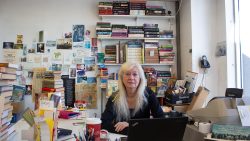Dave Fortier, a local artist, is colour-blind. He says he uses his disability as a tool for creation, a way to push for advocacy and to make a difference in the art community.
“Because somebody might not be set up as a typical person, doesn’t mean they should be held back in any capacity. … Some things that might be a challenge for other people might be a superpower for others,” says Fortier.
Fortier has been painting for most of his life but began to see it as a career in 2013. One of his latest shows, “Colour Blind,” was held at Urban Art Collective in Ottawa. The show featured an exhibit that encouraged using all senses.

“It gives you the full 360-degree experience … for some people on the spectrum or facing stimulation challenges, they really take to those things. … I think it’s really awesome to be able to experience art in a multitude of different ways,” Fortier says.
Many art institutions and galleries are working toward more accessible art in Ottawa. One is BEING Studio, a creative space in the Bronson Centre intended for artists dealing with developmental disabilities.

It is one of the art spaces redefining the lines and “boundaries” of the art community.
BEING Studio’s executive director, Walter Howell, says that accessibility can best be approached through empowerment.
“We [need to] gravitate towards a thought process of they’re just artists instead of [focusing] on the developmental disabilities. … We ensure that people can get into the studio and just get a chance to be supported,” says Howell.
Howell says most of the barriers in the art community are about the studio and in physical spaces. Doors are some times too small for wheelchairs. Buildings don’t have elevators.
To move forward, education and advocacy are the way to go, says Howell.
“I think what people are accustomed to are the old stigmas. … It’s not that they are ignorant, it’s something they haven’t been introduced to,” says Fortier.
The Ottawa Art Gallery says it practises accessibility in a lot of ways. Whether this means paying mind to physical accessibility in infrastructure or ensuring that art knowledge is intellectually accessible, a gallery official says it cares about accessibility.
Michael Davidge, manager of learning and engagement at the Ottawa Art Gallery, says one of the biggest ways the gallery promotes accessibility is through free admission. This allows people from all income levels to experience gallery services.
The Ottawa Art Gallery also offers free educational programs. One in particular is “Creative Space,” an arts workshop in partnership with the Royal Ottawa Mental Health Centre.
“We do a number of programs … so that we have greater social inclusion and [can] encourage the positive benefits of art-making to the community,” says Davidge.
Caroline Stewart, the gallery’s community programs coordinator, says the program serves as an art and wellness initiative for children, youths, adults and seniors who are being served by the Royal Ottawa Hospital.
The gallery holds Creative Space workshops online and in-person so they are accessible to those who have to join in from home, says Stewart.
“People can show up and just chat and spend time together and make art under the guidance of an art instructor.”
Stewart says in the art world, accessibility is always a part of the conversation and that programs must be open to all “financially, physically and also just in spirit.”
“The arts have always been a space meant to welcome those who are less welcome elsewhere,” says Stewart.
Step outside the box, redefine the rules on what’s kind of accepted and how something makes you feel. … It doesn’t always have to be the way it was. … It can be different
Dave Fortier, visual artist
However, barriers persist, says Stewart.
“Getting involved in the arts — getting your foot in the door — is always something that can be difficult.”
“[Art institutions] should open their doors so people don’t have to try and squeeze in.”
Better funding would help, says Stewart. “[It’s] a really big barrier as it stands now. Making things financially accessible to groups of all kinds would be a big step in the right direction.”
Fortier says he has dealt with varying barriers from purchasing the “correct” colours for a piece to honing his style of art, and he encourages artists, especially those with disabilities, to continue creating ways to overcome these challenges.
“Step outside the box, redefine the rules on what’s kind of accepted and how something makes you feel. … It doesn’t always have to be the way it was. … It can be different,” Fortier says.




